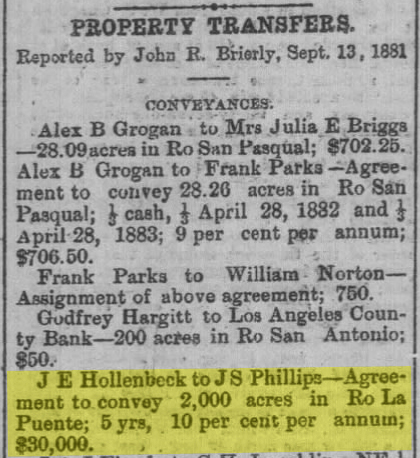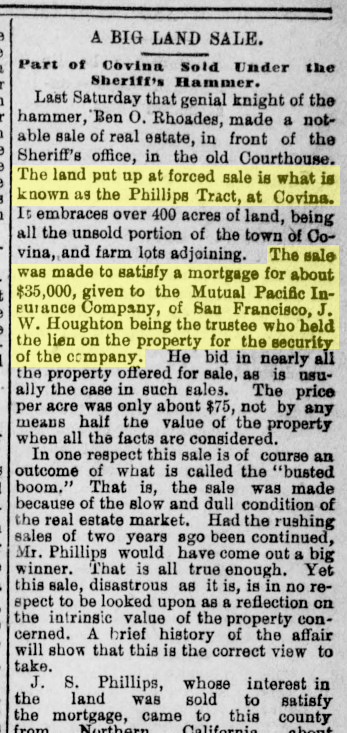One of the "facts" you'll find in every history of Covina is that in 1882, J. E. Hollenbeck sold 2,000 acres of his land in Rancho La Puente to J. S. Phillips for $30,000 where the latter founded Covina in 1885.1 It turns out that's not historically accurate, as you'll soon learn.
Just recently I found this conveyance involving Hollenbeck and Phillips, but it wasn't at all what I was expecting. In fact, when I saw it, it made my jaw drop, because if the accepted origin story of Covina is correct, it shouldn't exist.

Los Angeles Times, January 14, 1885.2
As you can see, in eighteen-eighty FIVE, Hollenbeck and Phillips jointly conveyed 195-3/4 acres in Rancho La Puente to James F. Houghton–trustee of the Pacific Mutual Life Insurance Co. of California–to secure a loan to J. S. Phillips in the amount of $40,000. (Put a pin in that for future reference.)
What's significant is that Hollenbeck couldn't convey title in real property he didn't own, so this a clear indication he didn't sell his land to Phillips outright. It appears he only entered into an agreement to sell, and retained ownership until the terms of the agreement were fulfilled. If true, that means Hollenbeck actually remained a "silent partner" in the Phillips Tract all along (or at least until Phillips putatively used that $40,000 to satisfy his indebtedness to Hollenbeck after he obtained the loan in January, 1885.)
It took me a while to find proof of the above claim, but here it is in black-and-white (and yellow!):

The Daily Commercial, September 15, 1881.3
So Phillips not only didn't purchase the land outright, Pflueger and other historians got the year wrong, too. We now know for certain that Hollenbeck was still technically an owner of the "Phillips" Tract, even after he made his deal with Phillips in 1881.

I also recently discovered something else that never made it into the history books. Pflueger1 chronicles the events in J. S. Phillips' life from 1882-1889 in often meticulous detail, but unless one attends carefully, a reader can easily skim past what ultimately happened to the founder of Covina, and even the single sentence devoted to the subject turns out to be a soft-pedaled vaguery of the actual turn of events that Phillips fell victim to in the end.
Quoting from page 204, this is all Pflueger has to say about the cessation of Joseph S. Phillips' association with the town he fathered:
He lost a large segment of his fortune in an investment in a northern California mine and was forced to sell his holdings in Covina and move elsewhere to regain his fortune.1
Well, as Paul Harvey used to say, you're about to find out "the rest of the story."

It was front page news in the June 3, 1889, edition of the Los Angeles Herald.4
First of all, notice there's Houghton and that life insurance company again: the same one that loaned Phillips $40,000 four years before. And apparently, judging by the remaining value of the mortgage, as mentioned in the newspaper article, Phillips had only managed to reduce his debt by $5,000 in all that time.
I suppose technically it was not inaccurate for Pflueger to say Phillips was "forced to sell his holdings," but the legal term "forced sale" is a synonym for foreclosure, which conveys a distinctly more negative connotation. With his equivocal phrasing, Pflueger almost made it sound like Phillips simply sold off his assets and moved on, but the hard fact of the matter was that Phillips had taken out a loan, he defaulted on repayment, and his remaining Covina properties were declared forfeit and seized. (A denouement interestingly similar to the Badillas before him.)
Heretofore, I would wager that not a single student of Covina history alive today was aware of Phillips' actual financial fate, or that Hollenbeck had retained a share of ownership in the Phillips Tract past 1882. (Both were certainly news to me!)
The full text of the newspaper article is transcribed below.
_____________
Part of Covina Sold Under the Sheriff's Hammer.
Last Saturday that genial knight of the hammer, Ben O. Rhoades, made a notable sale of real estate, in front of the Sheriff's office, in the old Courthouse. The land put up at forced sale is what is known as the Phillips Tract, at Covina. It embraces over 400 acres of land, being all the unsold portion of the town of Covina, and farm lots adjoining. The sale was made to satisfy a mortgage for about $35,000 given to the Mutual Pacific Insurance Company, of San Francisco, J. S. Houghton being the trustee who held the lien on the property for the security of the company. He bid in nearly all the property offered for sale, as is usually the case in such sales. The price per acre was only about $75, not by any means half the value of the property when all the facts are considered.
In one respect this sale is of course an outcome of what is called the "busted boom." That is, the sale was made because of the slow and dull condition of the real estate market. Had the rushing sales of two years ago been continued, Mr. Phillips would have come out a big winner. That is all true enough. Yet this sale, disastrous as it is, is in no respect to be looked upon as a reflection of the intrinsic value of the property concerned. A brief history of the affair will show that this is the correct view to take.
J. S. Phillips, whose interest in the land was sold to satisfy the mortgage, came to this county from Northern California about 1882. He did not have a large capital to back him, but he is a man of prodigious energy. He plunged in very deep in speculation on the Puente ranch, where he bought a large tract of fine land. He built a ditch from the mouth of the San Gabriel cañon, several miles long, and all cemented. He constructed a great reservoir and piped the water from this to a townsite which he named Covina, and to his lands. The sale of lots and of farm tracts was rapid, and soon Covina became quite a town. It is a very promising community today, with a large area of fine bearing orchards all around it. About 1885 he sold a large slice of his lands to some one who pretended to represent large capital in Chicago, and had that sale been fully consummated, Mr. Phillips would be a rich man today. But it fell through after much delay, and that crippled him. Then he got into a long and vexatious dispute with other interests about the water he took out of the San Gabriel, which cost him a great deal of money and delayed the sale of his lands.
In the meantime, Mr. Phillips had other irons in the fire. He had been a miner, and had big interests in holes in the ground up North, in some of the mountain counties. These were of the nature of the horseleech's daughters, and kept up a loud and prolonged cry, the burden of which was, "Give! Give!" To get money for his mines Mr. Phillips is reported to have sold a great deal of land at reasonable prices, getting very little down. In some cases, it is said he got not a dollar cash. He gave contracts and then hypothecated the paper to get money for his mining schemes. This prevented him from paying up on his lands, and at the time tied him up in a very bad way, preventing him from turning around in the present slow state of the market, and thus all he had went by the board.
Mr. Phillips deserved a better fate; he is a man of great energy, and had matters gone smoothly with him he would at once have developed in a very marked manner a delightful bit of this section, and made himself a very rich man. The moral of it all is that he segregated from the original mass a more extended portion than he was able to masticate. He is not alone in this matter, but has companions in misery. But the comfort derivable from this fuel is rather cold in its nature.4

References:
1 Pflueger, D. H. 1964. Covina: Sunflowers, Citrus, Subdivisions. Castle Press, Pasadena, California, 372pp.
2 Los Angeles Times, January 14, 1885, p.3.
3 Los Angeles Herald, September 14, 1881, p.3, and The Daily Commercial, September 15, 1881, p.3.
4 Los Angeles Herald, June 3, 1889, p.1.
No comments:
Post a Comment
To post a comment, you must login to this page with the Google Chrome web browser. That is the only way that works now.